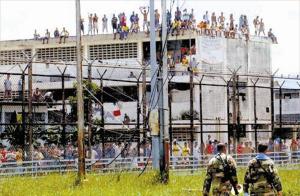The PGV is just one small glimpse of hell

Tocuyito Prison (located outside Valencia) was the most violent prison in Venezuela last year with 61 deaths.
The Guardian’s Virginia Lopez offers a inside look into the General Penitentiary of Venezuela (the PGV), located in Guárico State. While she’s not the first journalist to go inside this prison, she offers a hair-raising report.
The PGV is dubbed “the Beverly Hills of Venezuelan prisons”, but that doesn’t change the fact that behind its walls, power doesn’t belong to the State, but to gang chieftains known as pranes. Take it away, Virginia:
For the prisoners at the general penitentiary, in San Juan de los Morros, 55 miles south of Caracas, that means jail can seem like a surreal, hedonistic pleasure palace, or the cruellest hellhole. It depends what side of the jail they are in.
Divided from the main hallways by a pockmarked wall is an area designated by prison leaders for those prisoners judged too unruly to abide by unwritten prison codes. In this “jail within a jail”, the music is barely audible and no one is in the mood to party. Emaciated men live on top of one other in makeshift hammocks made of tattered sheets. Many cough – the result of a TB epidemic that goes largely unreported and untreated. Walls are riddled with bullet holes and the stench of sewage mixes with the scent of marijuana.
Most men here do nothing but wait out a sentence that has yet to arrive. Human rights activists say almost 70% of inmates are being held in pre-trial detention. Some do odd jobs, such as fixing broken air-conditioners or painting the walls of the main prison. Their wages – paid by the pran – finance their drug habits.
As Human Rights Watch put it in its 2013 World Report, the situation is one of “…weak security, deteriorating infrastructure, overcrowding, insufficient and poorly trained guards, and corruption allow armed gangs to effectively control prisons.”
After the terrible events in Uribana Prison, the crisis of our penitentiary system continues to be very grim. The latest findings of the NGO Venezuelan Prisons Observatory (OVP) in its annual report confirms it and, given that the official policy is to withhold any official information (with some counted exceptions) this is probably the closest we can come to finding out about what is really happening.
Last year, there were 591 deaths in our jails, 31 more than in 2011. In the eighteen months since the creation of the Prison Ministry, 869 inmates have lost their lives and 1,685 have been injured. Shortly after the OVP report went public, one of the Ministry’s employees was caught trying to introduce ammunition into Santa Ana Prison … through an ambulance.
The biggest problem continues to be overcrowding: as of December 31st, the total number of inmates was 48,262 and 60% of them had not been sentenced. All Venezuelan prisons combined have a capacity for 16,539 people, and right now there’s an excess of 31,723, which is more than double. The recent closing of Uribana has just made matters even worse.
Meanwhile for one inmate killed in Uribana, death was not even the end of his journey to hell. In what must count as one of the most garishly over-the-top examples of the country’s headlong descent into lunacy, one of the prans killed at Uribana recently had his gravesite dug up in the middle of the night, his remains doused in gasoline and then set on fire. True story.
(HT: Mayke Santos)
Caracas Chronicles is 100% reader-supported.
We’ve been able to hang on for 22 years in one of the craziest media landscapes in the world. We’ve seen different media outlets in Venezuela (and abroad) closing shop, something we’re looking to avoid at all costs. Your collaboration goes a long way in helping us weather the storm.
Donate




